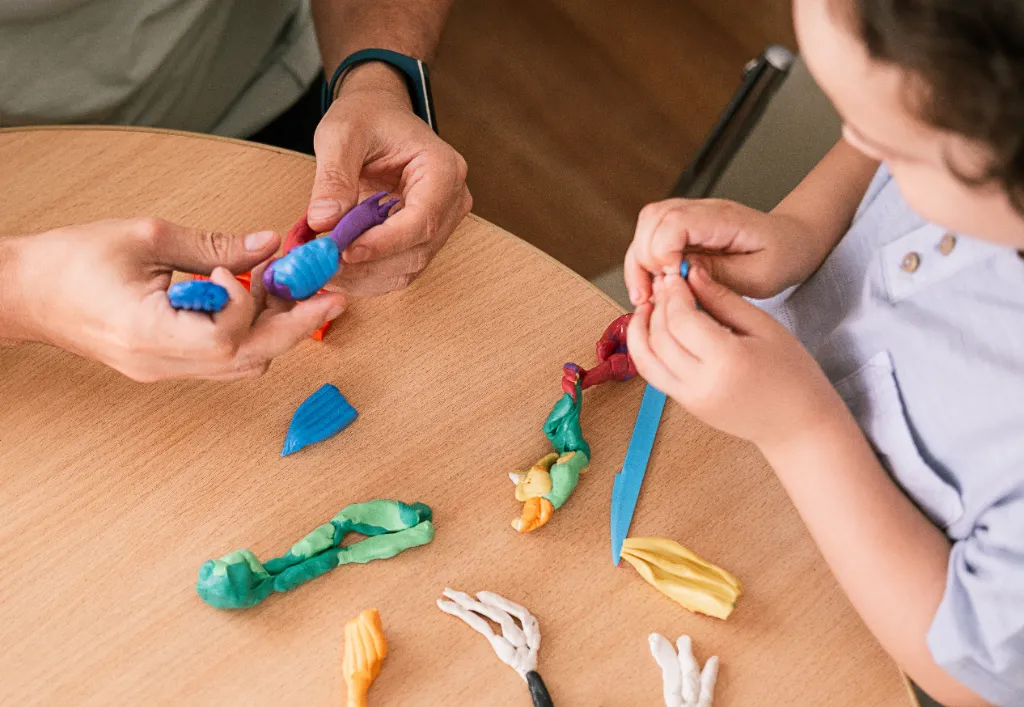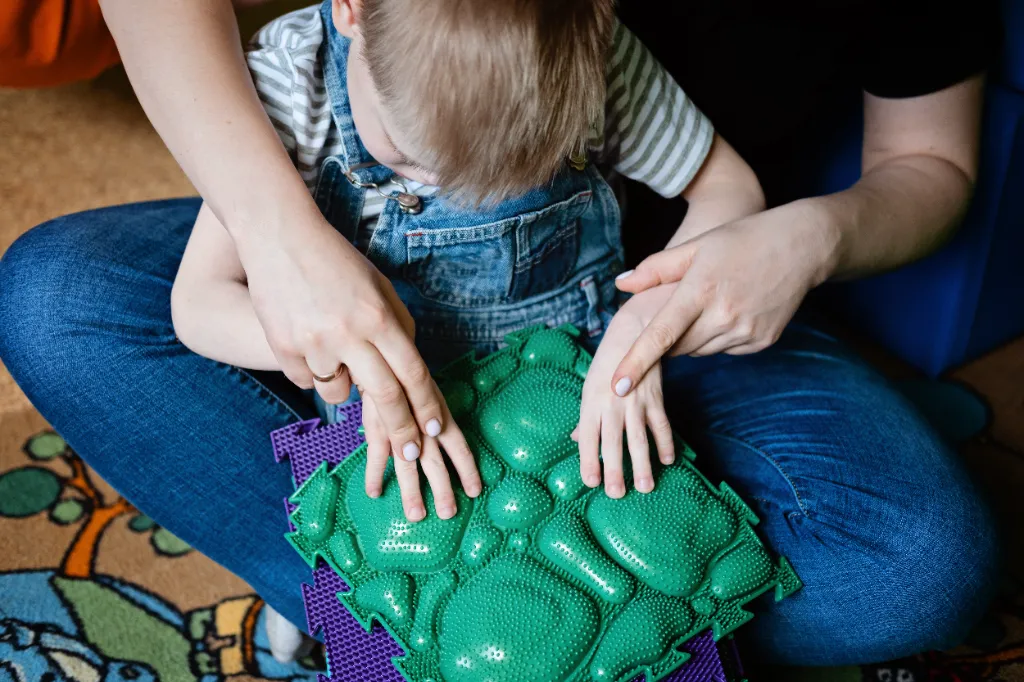Sensory Processing in Autism
Sensory processing refers to how the nervous system receives, organises, and interprets sensory inputs and then produces behaviour or responses. For autistic people, the sensitivity to sensory information is often different and can affect daily functioning in multiple ways. The common presentations are hypersensitivity, hyposensitivity, sensory stimming, cross-modal effects (a noisy and visually stimulating environment that triggers combined effects) and behavioural consequences (distress, anxiety, burnouts, withdrawal, meltdowns, or shutdowns).
Besides the familiar five senses (sight, hearing, taste, smell, touch), the following senses are involved:
- Proprioception (body position/force),
- Vestibular (balance/movement),
- Interoception (internal body signals like hunger, pain, temperature).
What Are Sensory Activities for Autistic Children?
Sensory activities are purposeful and planned experiences or games designed to give autistic children the sensory input they need to improve fine motor skills. in a safe, structured way. They can calm, alert or organise the brain’s responses to different textures, making day-to-day life easier.
- They can calm (reduce sensory overload)
- or alert/stimulate (increase attention or awareness)
- or teach self-regulation (recognising their own sensory needs).
Occupational therapists often call this a “sensory diet”, not food-related, but a planned mix of sensory experiences across the day.
Many sensory play ideas can be tailored to a child’s needs and preferences, including ones that involve. For example, water sensory play can be incredibly soothing and provide tactile and visual stimulation. This can be as simple as a water table with different toys, or a sensory bath with bubbles or colored water. Weighted blankets or therapy balls can also be used for proprioceptive input, helping children understand their body’s position in space. Sound games using different musical instruments or exploring natural sounds can benefit children with auditory sensitivities. Sensory bins filled with materials like sand, rice, or beans offer a tactile experience. In contrast, visual sensory stimulation can be provided through activities like light table play or colour sorting.
What Are Good Sensory Items for Autism?
Because every autistic person’s sensory profile differs, the best items are chosen individually after observing what helps or hinders.
Examples of good sensory items widely used in UK therapy, homes and schools:
- Fidget toys (spinners, stress balls, fidget cubes, squishy toys) for tactile stimulation and focus
- Weighted blankets, resistance bands, body socks or lap pads to provide deep pressure calming
- Sensory brushes and tactile balls for touch stimulation
- Noise-reducing headphones, white-noise machines, or calming music playlists to reduce overwhelming sounds
- Visual sensory toys like bubble tubes, lava lamps, fibre-optic lights or light projectors
- Playdough or putty for hand strengthening and tactile exploration
- Vibrating toys or cushions for gentle proprioceptive feedback
Create a calming, multisensory space with these items, personalising with the child’s choices.
And here you can read more about creating calming sensory room ideas for autistic people.
The Benefits of Sensory Activities
Sensory activities are an integral part of development for all children, and their significance is further amplified in the context of. These activities involve deliberately engaging one or more of the senses to help children better understand, interpret, and respond to their environment.
The benefits of sensory toys are multifaceted, affecting cognitive, physical, emotional, and social aspects of development, making sensory activities indispensable to comprehensive therapeutic and educational strategies.
What benefits look like in real life:
- Improved self-regulation – Children learn to recognise when overwhelmed and use sensory tools (weighted pad, ear defenders, movement breaks) to calm themselves.
- Reduced anxiety and meltdowns – Structured sensory breaks and calming activities reduce fight/flight responses and emotional outbursts.
- Better attention and focus – ”Heavy work” or movement activities before school tasks help some autistic children sit, listen and learn better.
- Safe outlet for sensory stimming – Gives children an appropriate way to meet sensory needs (e.g. jumping on a trampoline instead of unsafe climbing).
- Greater participation in everyday routines – With the correct sensory input, dressing, eating, toothbrushing, homework and social activities become less stressful.
- Enhanced motor and coordination skills – Activities like obstacle courses and therapy putty or balance games build strength and body awareness.
- Positive shared experiences – Many sensory activities (baking, water play, massage with a sensory brush) can be done with parents, siblings or support workers, strengthening relationships.
In conclusion, sensory play activities are influential in promoting holistic development. They offer a fun, engaging, and inclusive way of learning that caters to differences and needs, including a calming effect, ultimately setting the stage for children to be successful and adaptive learners.
Sensory Ideas for Autism
Navigating the sensory world can be a unique challenge for autistic children. Sensory activities, designed to stimulate and engage the senses, can help children understand their environment and improve their sensory processing skills. From the vibrant swirls of food colouring in the water to the scent of homemade playdough, these activities offer a multisensory approach that enriches children’s learning experience. These sensory ideas foster creativity and imagination and serve as a therapeutic tool, enhancing cognitive, physical, emotional, and social development.
Scented Playdough
Scented playdough emerges as an engaging and effective sensory tool for autistic children. The malleable nature of playdough allows for tactile stimulation exploration, as children can squeeze, roll, flatten, and mould it, stimulating fine motor skills and hand-eye coordination. It also provides an excellent creative medium, encouraging imaginative play and cognitive development.

The addition of scent takes the sensory experience a step further. The sense of smell is closely linked to emotions and memories. By associating different scents with the calming activity of manipulating playdough, children can learn to associate these scents with feelings of relaxation and calmness. This can help them manage sensory overload or anxiety, promoting emotional self-regulation.
Scented playdough can also be a valuable tool for social interaction. When used in a group setting, it encourages cooperative play and sharing. Children can describe their creations and the scents they experience, fostering language development and social communication skills.
Food Colouring
Food colouring offers a fascinating and engaging sensory tool for autistic children. It’s a versatile resource for many sensory activities, providing vibrant visual stimulation that can hold a child’s attention. Most importantly, it allows children to explore and understand the world of colours, promoting cognitive development and creativity.
Food colouring can also be incorporated into other sensory materials like slime, playdough, or sensory rice. Children can engage in tactile exploration with these materials while also enjoying the added visual stimulation from the vibrant colours.
Water Balloon Play
Water balloon play emerges as a unique and enjoyable sensory tool for children with autism. It provides a great way to engage multiple senses simultaneously in a controlled environment, offering tactile, visual, and proprioceptive experiences. It’s an activity that can be tailored to fit a child’s individual sensory needs, and its benefits range from improving gross motor skills to facilitating social interactions.
Visually, water balloons are colourful and engaging. When a balloon bursts, the splashing water can be visually stimulating and evoke excitement and anticipation. For children who might be hypersensitive to sudden splashes, starting with smaller balloons or ones that are not fully filled might make the experience more comfortable.
Trampolines
Trampolines are another sensory play tool for autistic children, offering a range of benefits that span sensory and motor skills development. Bouncing on a trampoline provides a unique sensory experience, combining proprioceptive and vestibular inputs that can enhance body awareness, contribute to improved sensory processing, and help develop social skills.


This can be particularly beneficial for children who feel stressed or uncomfortable when sensory input becomes overwhelming. Jumping can create sensations that soothe and calm autistic children, helping them release stress and anxiety.
Safety Tips for Sensory Play
Sensory play is widely used in the UK to support autistic children’s development and self-regulation. According to the National Autistic Society, over 70% of autistic people experience significant sensory differences, and many schools and families use structured sensory activities to help with calmness, focus and skill-building.
However, without clear safety measures, even simple sensory activities (water, rice, weighted items, swings) can create risks such as choking, allergic reactions or overload. Following basic safety tips makes sensory play both enjoyable and secure.
Safety Tips:
- Supervise at all times during sensory play, even “safe” materials can become choking or slipping hazards.
- Check each child’s sensory profile to avoid triggers that cause distress, meltdowns or allergic reactions.
- Use age-appropriate materials (larger items for under-3s; avoid beads, water beads, small buttons for younger children).
- Choose non-toxic, washable, food-grade materials for messy play (paint, rice, dough).
- Be allergy-aware – no nuts or scented oils if allergies are suspected. Always check labels.
- Gradually introduce new textures, smells or movement, allowing the child to opt out.
- Ensure a clean, safe environment – non-slip mats under messy trays; clear surrounding space.
- Provide a nearby quiet area so the child can retreat if overwhelmed.
- Supervise all movement equipment (swings, trampolines, rocking chairs); limit time to avoid dizziness.
- Follow professional guidance for weighted items – correct weight, safe duration; never use on a sleeping child.
- Practice good hygiene – wash hands before/after play; clean or replace materials (water, sand, rice) regularly.
- Store sensory items separately for each child where possible (especially chewables and fidgets).
- Inspect toys and equipment frequently for cracks, loose parts or wear.
- Explain activities in advance using visuals or social stories; respect the child’s “no” to avoid increasing anxiety.
Creating a Sensory-Friendly Environment at Home
A sensory-friendly home helps autistic children feel calmer, safer and more able to engage in everyday activities through the use of different senses . Because over two-thirds of autistic people experience sensory differences to lighting, sound, texture, and routine can dramatically reduce stress and meltdowns. It’s not about expensive equipment, and many adjustments are simple and low-cost.
Key approaches include:
- Lighting: Use soft, natural or dimmable lighting instead of harsh fluorescents.
- Sound: Reduce background noise (TV, appliances) and provide noise-cancelling headphones if needed.
- Visual clutter: Keep décor simple and organised to avoid overstimulation.
- Texture choices: Offer soft furnishings (blankets, rugs) and avoid scratchy fabrics on frequently used furniture.
- Calm spaces: Create a small “quiet corner” with cushions or a tent where the child can retreat.
A sensory-friendly environment also means thinking about predictability and control. Offering clear routines and safe sensory outlets can help children self-regulate and build confidence at home.
Additional tips:
- Flexible zones: Set aside a space for movement (mini-trampoline, swing) and one for calm activities (reading, fidget toys).
- Visual schedules: Use pictures or symbols to show daily routines.
- Personal choice: Involve the child in choosing textures, colours and sensory tools.
- Regular review: Adjust the environment as the child’s needs change.
Tailored Autism Care with Unique Community Services
At Unique Community Services, we’re committed to providing person-centred and holistic care. Our team of dedicated professionals create supportive environments that encourage autistic children to explore, learn, and grow at their own pace. Each child’s needs and preferences are respected, ensuring they receive care and support tailored to them.
Join us in our mission to provide humanised care and create positive change in the lives of autistic children. Together, we can make a world that understands, accepts, and celebrates every child’s unique abilities.
Now, meet William and witness how the right support can bring a fundamental change, a real difference in a person’s life.
Contact us today to learn more about our humanised support, or make a referral to our therapy team.
Offices: Manchester and Leeds




